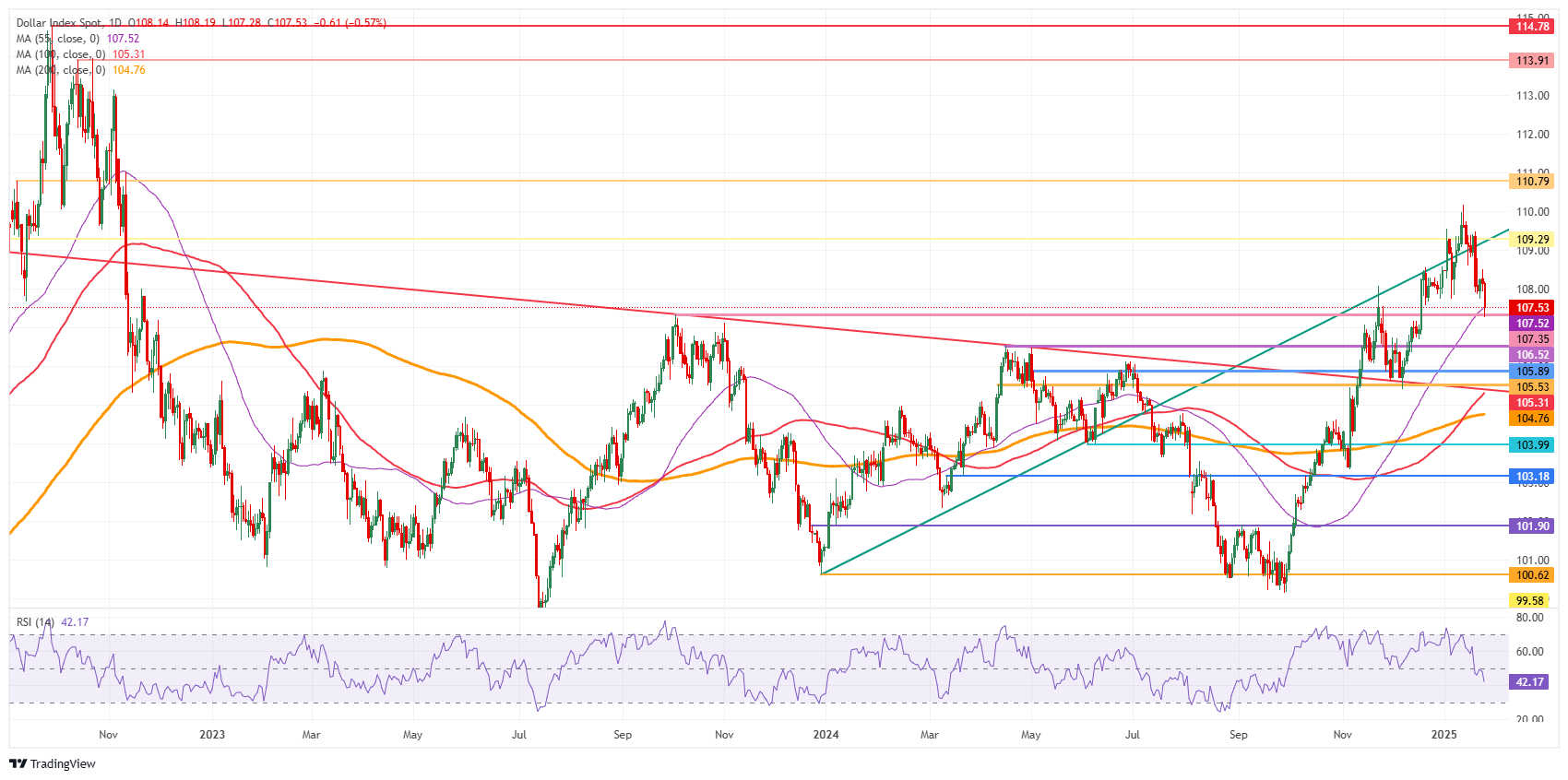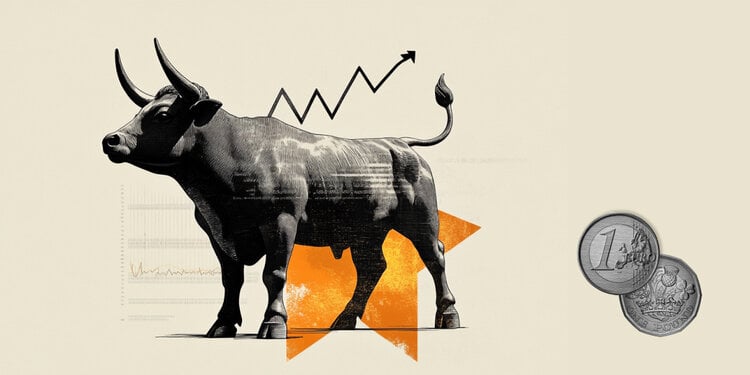- The US dollar downward all its main peers.
- The president of the USA, Trump, commented that tariffs on China may not finally impose themselves.
- The US dollar index (DXY) continues to quote below 108.00 despite a small rebound from the minimum of this week.
The US dollar index (DXY), which tracks the performance of the US dollar against six different main currencies, is emerging again above 107.50, although it continues to face an intra -trial loss on Friday after the US president. , Donald Trump, surprised with comments the previous day that they threw doubts about the application of tariffs to China. The comments occurred after Trump had a phone call with Chinese president Xi Jinping. Meanwhile, the Bank of Japan (BOJ) raised interest rates at 25 basic points, which caused substantial losses for the US dollar (USD) compared to Japanese yen (JPY).
In the front of the economic data, Markit has already published the preliminary readings of the Purchase Managers Index (PMI) of Germany for January, with some very optimistic numbers, which drives more the strength of the euro (EUR) against the US dollar (USD). Later this Friday, the US will receive its preliminary readings of the Global S&P PMI for the same month. The University of Michigan will close the day with the final reading of its consumer’s feeling index for January.
Daily market summary: the PMI could be interesting
- The president of the USA, Donald Trump, commented on his phone call with Chinese President Xi Jinping. He surprised the markets in saying that he does not want to impose tariffs on China, Bloomberg reported.
- The president of the USA, Trump, commented on the Federal Reserve and the US rates, stating that he would demand an immediate cut in the US interest rates, Bloomberg reports.
- Germany saw its preliminary services PMI jump to 52.5 in January, exceeding the estimate of 51.0 and above the previous 51.2. The compound PMI managed to get out of the contraction, reaching 50.1 and exceeding 48.2 expected and the previous 48.0.
- At 14:45 GMT, USA will receive its preliminary reading of the January PMI of S&P global:
- The services are expected to soften 56.5, coming from 56.8 in the final reading of December.
- Manufacturing is expected to remain in contraction in 49.6, coming from 49.4.
- At 15:00 GMT, the final reading of the consumer’s feeling index of the University of Michigan is expected to remain stable at 73.2. The 5 -year inflation expectations component is expected to also remain unchanged at 3.3%.
- The shares are mixed, with China and Europe in positive territory while markets reduce the risk of Trump tariffs. However, after that same holder, US actions face a setback and are quoting negatively.
- The CME Fedwatch tool projects a 52.2% probability that interest rates will remain unchanged in current levels at the May meeting, suggesting a feature cut in June. The Federal Reserve (Fed) is expected to remain dependent on the data with uncertainties that could influence inflation during the mandate of the US president, Donald Trump.
- The 10 -year performance of the US is quoting around 4,639%, far from its poor performance seen earlier this week in 4,528% and still has a long way to go to the maximum of more than a year of the last week at 4,807%.
Technical analysis of the DXY dollar index: a completely different Trump
The US dollar index (DXY) is receiving some blows and heading down, hand in hand with US yields although the US president Trump could suddenly soften his position on tariffs, still It is early in his mandate to rule out any implementation of tariffs to China and other countries. Tail risks are being formed, with the markets beginning to minimize the current position, which could still see a recovery of the US dollar if Trump imposes tariffs on China.
The DXY has a job to do to recover the levels seen at the beginning of this week. First, the great psychological level in 108.00 needs to be recovered. From there, 109.29 (Maximum of July 14, 2022 and a line of ascending trend) is the following to recover the losses incurred this week. Above, the next climbing level to be achieved before progress is still 110.79 (maximum of September 7, 2022).
Downwards, the convergence of the maximum of October 3, 2023 and the simple mobile average (SMA) of 55 days around 107.50 should act as a double security feature to support the price of the DXY. For now, that seems to be maintained, although the relative force index (RSI) still has some space towards decline. Therefore, it is better to look for 106.52 or even 105.89 as the best levels for the US dollar bundles to get involved and trigger a reversal.
US dollar index: daily graphics
US interest rates
Financial institutions charge interest rates on loans to borrowers and pay them as interest to savers and depositors. They influence the basic types of interest, which are set by central banks based on the evolution of the economy. Normally, central banks have the mandate to guarantee the stability of prices, which in most cases means setting as an objective an underlying inflation rate around 2%.
If inflation falls below the objective, the Central Bank can cut the basic types of interest, in order to stimulate credit and boost the economy. If inflation increases substantially above 2%, the Central Bank usually rises the interest rates of basic loans to try to reduce inflation.
In general, higher interest rates contribute to reinforce the currency of a country, since they make it a more attractive place for world investors to park their money.
The highest interest rates influence the price of gold because they increase the opportunity cost of maintaining gold instead of investing in an asset that accrues interest or depositing effective in the bank.
If interest rates are high, the price of the US dollar (USD) usually rises and, as gold quotes in dollars, the price of low gold.
The federal funds rate is the type to a day that US banks lend each other. It is the official interest rate that the Federal Reserve usually sets at its FOMC meetings. It is set at a fork, for example 4.75%-5.00%, although the upper limit (in this case 5.00%) is the aforementioned figure.
Market expectations on the interest rate of the Federal Reserve funds are followed by the Fedwatch of the CME tool, which determines the behavior of many financial markets in the forecast of future monetary policy decisions of the Federal Reserve.
Source: Fx Street
I am Joshua Winder, a senior-level journalist and editor at World Stock Market. I specialize in covering news related to the stock market and economic trends. With more than 8 years of experience in this field, I have become an expert in financial reporting.








